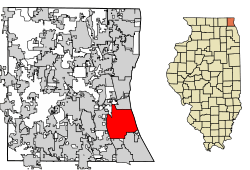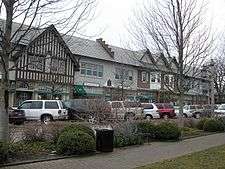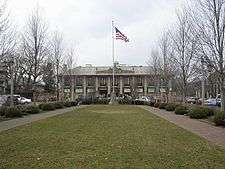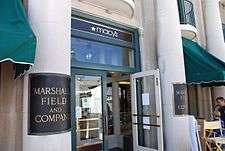Lake Forest, Illinois
| Lake Forest, Illinois | |
|---|---|
| City | |
|
Lake Forest City Hall | |
 Location of Lake Forest in Lake County, Illinois. | |
.svg.png) Location of Illinois in the United States | |
| Coordinates: 42°14′5″N 87°51′3″W / 42.23472°N 87.85083°WCoordinates: 42°14′5″N 87°51′3″W / 42.23472°N 87.85083°W | |
| Country | United States |
| State | Illinois |
| County | Lake |
| Township | Moraine, Shields, Vernon, West Deerfield |
| Founded | 1861 |
| Government | |
| • Mayor | Robert T. E. Lansing[1] |
| Area[2] | |
| • Total | 17.24 sq mi (44.66 km2) |
| • Land | 17.18 sq mi (44.49 km2) |
| • Water | 0.07 sq mi (0.17 km2) |
| Population (2010) | |
| • Total | 19,375 |
| • Estimate (2016)[3] | 19,388 |
| • Density | 1,128.59/sq mi (435.75/km2) |
| Time zone | UTC−6 (CST) |
| • Summer (DST) | UTC−5 (CDT) |
| ZIP Code | 60045 |
| Area code(s) | 847, 224 |
| FIPS code | 17-41105 |
| Wikimedia Commons | Lake Forest, Illinois |
| Website |
www |
Lake Forest is a city located in Lake County, Illinois, United States. As of the 2010 census it had a population of 19,375.[4] The city is along the shore of Lake Michigan, and is a part of the Chicago metropolitan area and the North Shore.
Lake Forest was founded together with Lake Forest College; it was laid out as a town in 1857, and was a stop for travelers making their way south to Chicago. The Lake Forest City Hall, designed by Charles Sumner Frost, was completed in 1898. It originally housed the fire department, the Lake Forest Library, and city offices.[5] The city used restrictive covenants to bar "African-Americans and Jews from purchasing property in Lake Forest", a practice that "continued at least until the 1960s", but which seems to have been "greatly diminished" by the 1990s.[6]
Geography
Lake Forest is located in the North Shore area of Chicago, at 42°14′5″N 87°51′3″W / 42.23472°N 87.85083°W (42.234788, -87.851042).[7]
According to the 2010 census, Lake Forest has a total area of 17.246 square miles (44.67 km2), of which 17.18 square miles (44.50 km2) (or 99.62%) is land and 0.066 square miles (0.17 km2) (or 0.38%) is water.[8]
History
The Potawatomi inhabited Lake County before the United States Federal Government forced them out in 1836 as part of Indian Removal of tribes to areas west of the Mississippi River.[9]
As Lake Forest was first developed in 1857, the planners laid roads that would provide limited access to the city in an effort to prevent outside traffic and isolate the tranquil settlement from neighboring areas. Though the town is considerably more accessible today, due in part to the extensive new construction taking place further west, the much smaller neighborhood of eastern Lake Forest, near the coast of Lake Michigan, remains relatively secluded. It is one of the most scenic, historical, and architecturally significant suburbs of Chicago. These neighborhoods include estates and homes designed by distinguished architects such as Howard Van Doren Shaw, David Adler, Frank Lloyd Wright, Arthur Heun, Jerome Cerny, Henry Ives Cobb, and modernist George Fred Keck, among others. Landscape architects Frederick Law Olmsted and Jens Jensen also designed projects in Lake Forest. Market Square, designed by Howard Van Doren Shaw, was completed in 1916 as a commercial center for Lake Forest.
The secluded style of Lake Forest was intended as a form of protection. According to the president of the Lake Forest-Lake Bluff Historical Society, the captains of industry and upper-class elite who first settled in Lake Forest sought a refuge from late 19th and early 20th-century Chicago. In their view, the city was overrun with immigrants from southern and eastern Europe who had dangerous socialist ideas and indulged in excessive alcoholic consumption.[9]
Country clubs became important centers of social activity in Lake Forest's early decades. The Onwentsia Club was, in the words of one writer, "the premiere social and sporting club in the Midwest".[9] In 1898, members held a plantation-themed party, dining on fried chicken, corn on the cob, and watermelon served by—in keeping with the party's theme—"little colored girls".[10] After-dinner entertainment included a minstrel show.[10] This was a period in United States history in which there was considerable interest in Southern culture and the mythical plantation society. Both the North and South were active in memorializing their contributions to the Civil War, as well as achieving a kind of reconciliation that, according to historian David W. Blight, pushed issues of race to the side.[11]
One of Lake Forest's most notable features is its virgin prairies and other nature preserves. In 1967, a group of 12 long-time residents of Lake Forest formed a land conservation organization, Lake Forest Open Lands Association.[12] Its express purpose was to purchase or otherwise set aside the rapidly disappearing open spaces in the city, in the interests of preserving animal habitat, restoring ecosystems, and providing environmental education for the city's children. In the next 38 years, the group managed to acquire more than 700 acres (2.8 km2) within the city limits, which now form six nature preserves with 12 miles (19 km) of walking trails open to the public.
Preserved in perpetuity are wetlands, original pre-1830 prairie, woodland, and savanna, all within the community. The restoration of these lands is celebrated by an annual "Bagpipes and Bonfire" event in September, which started as a community event in which controlled fires were burned to clear underbrush and preserve the savannah. From an early time, the playing of bagpipes has accompanied the community gathering, as the town had numerous Scots-Irish residents in its early years. This has also been an annual fundraising event for Lake Forest Open Lands Association.[13]
The Ragdale Foundation, an artists' community and residence, is located in Lake Forest. Formerly Howard Van Doren Shaw's summer retreat and built in 1897, the estate has accommodated notable artist Sylvia Shaw Judson.
In 1992, Lake Forest gained national attention when it attempted to ban the sale of offensive music to anyone under the age of 18.[14] City council members used existing ordinances against obscenity—defined in the codes as "morbid interest in nudity, sex or excretion"—to buttress their campaign.[14] Mayor Charles Clarke stated, "If they sell an obscene tape to somebody underage, we will prosecute."[14] The person who came up most frequently in discussions of obscene content was Ice-T, a rapper who has since also performed as an actor.
Lake Forest has been named a Tree City USA by the National Arbor Day Foundation in recognition of its commitment to community forest. As of 2006, Lake Forest had received this national honor for 26 years. The actor Mr. T notably angered the town by cutting down more than 100 oak trees on his estate, in what is now referred to as the "Lake Forest Chain Saw Massacre."[15]
Commercial development



Commercial development in Lake Forest is focused in three areas, two of which have public railway stations. The central business district includes a Metra commuter railroad station on the Union Pacific/North Line. It extends beyond Market Square, providing a mixture of retail, banking, and professional services, as well as restaurants. Market Square is composed of a wide variety of shops and restaurants, including Talbots, Williams-Sonoma, J.Crew, and Einstein Bros. Bagels. The business district to the west includes a Metra commuter railroad station on the Milwaukee District/North Line. It extends beyond Settlers' Square to provide a mixture of retail, banking and professional services, as well as restaurants. A third area of business development, consisting mostly of corporate and office space, has been developed along the city's northwestern border with the Tri-State Tollway.
The headquarters of Fortune 500 companies Tenneco, Brunswick, and Hospira are located in Lake Forest; Covered Logistics, IDEX, Packaging Corporation of America, Pactiv, Prestone, and Trustmark also have their headquarters in Lake Forest, while W. W. Grainger and BFG Technologies are located in unincorporated Lake County, near Lake Forest. The Chicago Bears training facility and headquarters, Halas Hall, opened in 1997 in west Lake Forest, and the Chicago Fire now train at the Bears' previous facility located on the campus of Lake Forest.
Lake Forest is the base for Linking Efforts Against Drugs (LEAD),[16] a national organization aimed at discouraging youth from getting involved in drugs. It empowers parents and community members to encourage the drug-free choice.
Top employers
According to Lake Forest's 2014 Comprehensive Annual Financial Report,[17] the top employers in the city are:
| # | Employer | # of Employees |
|---|---|---|
| 1 | Northwestern Lake Forest Hospital | 1,600 |
| 2 | Hospira | 1,350 |
| 3 | Trustmark Companies | 800 |
| 4 | Solo Cup Company | 600 |
| 5 | Lake Forest College | 500 |
| 6 | Lake Forest Community High School District 115 | 350 |
| 7 | Pactiv | 300 |
| 8 | City of Lake Forest | 275 |
| 9 | Brunswick | 200 |
| 10 | Packaging Corporation of America | 200 |
Demographics
| Historical population | |||
|---|---|---|---|
| Census | Pop. | %± | |
| 1880 | 877 | — | |
| 1890 | 1,203 | 37.2% | |
| 1900 | 2,215 | 84.1% | |
| 1910 | 3,349 | 51.2% | |
| 1920 | 3,657 | 9.2% | |
| 1930 | 6,554 | 79.2% | |
| 1940 | 6,885 | 5.1% | |
| 1950 | 7,819 | 13.6% | |
| 1960 | 10,687 | 36.7% | |
| 1970 | 15,642 | 46.4% | |
| 1980 | 15,245 | −2.5% | |
| 1990 | 17,836 | 17.0% | |
| 2000 | 20,059 | 12.5% | |
| 2010 | 19,375 | −3.4% | |
| Est. 2016 | 19,388 | [3] | 0.1% |
| U.S. Decennial Census[18] | |||
As of the 2010 United States Census,[19] there were 19,375 people residing in the city. The racial makeup of the city was 92.11% White, 4.67% Asian, 2.80% Hispanic or Latino (of any race), 1.30% of two or more races, 1.10% Black or African American, 0.14% Native American, 0.01% Pacific Islander, and 0.68% of some other race.
As of the census[20] of 2000, there were 20,059 people, 6,687 households, and 5,329 families residing in the city. The population density was 1,189.4 people per square mile (459.1/km²). There were 7,001 housing units at an average density of 415.1 per square mile (160.2/km²). The racial makeup of the city was 95.80% White, 1.35% African American, 0.06% Native American, 2.45% Asian, 0.13% Pacific Islander, 0.44% from other races, and 0.77% from two or more races. Hispanic or Latino of any race were 0.87% of the population.
There were 6,687 households out of which 39.0% had children under the age of 18 living with them, 73.6% were married couples living together, 4.7% had a female householder with no husband present, and 20.3% were non-families. Of all households 18.3% Of all households were made up of individuals and 9.6% had someone living alone who was 65 years of age or older. The average household size was 2.78 and the average family size was 3.17.
In the city, the population was spread out with 27.5% under the age of 18, 9.6% from 18 to 24, 19.7% from 25 to 44, 28.6% from 45 to 64, and 14.6% who were 65 years of age or older. The median age was 41 years. For every 100 females, there were 90.8 males. For every 100 females age 18 and over, there were 86.5 males.
According to a 2007 estimate, the median income for a household in the city was $150,670, and the median income for a family was more than $200,000. Males had a median income of $100,000+ versus $44,083 for females. The per capita income for the city was $77,092. About 0.15% of families and 0.2% of the population were below the poverty line.
Transportation
Lake Forest has Interstate Highway access through the Tri-State Tollway (I-94). In addition, the Skokie Highway (U.S. Highway 41) runs through Lake Forest, roughly bisecting the city. Lake Forest is connected with suburbs west of it through Illinois Route 60. Additionally, Lake Forest has two Metra commuter railroad stations, both of which share the same name. The Union Pacific/North Line has a station in East Lake Forest, while the Milwaukee District/North Line has a station in West Lake Forest.
Education
Most Lake Forest residents attend Lake Forest School District 67 and Lake Forest High School. Lake Forest High School serves Lake Forest as well as neighboring Lake Bluff and Knollwood.
Elementary schools
- Deer Path Middle School—public
- Cherokee Elementary School—public
- Everett Elementary School—public
- Sheridan Elementary School—public
- Lake Forest Country Day School—private
- School of St. Mary—private
- East Lake Academy; private
- Montessori School of Lake Forest—private; Montessori[21]
- Forest Bluff School—private; Montessori; in neighboring Lake Bluff; majority of students live in Lake Forest[22]
High schools
- Lake Forest High School—public
- Lake Forest Academy—private
- Woodlands Academy of the Sacred Heart—private
Colleges
- Barat College—closed on 30 June 2005 after 100 years in Lake Forest
- Lake Forest College
- Lake Forest Graduate School of Management
Notable people
Arts and entertainment
Lake Forest is home to Citadel Theatre,[23] the Lake Forest Symphony,[24] the Music Institute of Chicago Lake Forest Campus and the Deer Path Art League.
Polo
Lake Forest is noted in the Chicago area for its history of polo, once being the westernmost establishment of the sport in the United States. It was home to the "East-West clash of 1933", in which a team of "Westerners" (who would today be considered Midwesterners), challenged the best of the Eastern US polo teams, winning two of three matches. Box seats sold for $5.50, and the general public was admitted for $1.10. The Chicago press covered the match extensively, including the arrival of every horse and player, the color of the horseflesh, and the color of the goalposts. The match was described as a "gleaming moment in American polo, if not the very zenith of the game in this country." In the early 21st century, Lake Forest continues the tradition, and polo is played yearly throughout August.
In popular culture
Literature
- The Group has a character named Lakey from Lake Forest.
- The Great Gatsby, by F. Scott Fitzgerald; the character of Tom Buchanan imports his "string of polo ponies" from a Lake Forest farm to Long Island, New York.
- A Heartbreaking Work of Staggering Genius by Dave Eggers; Dave (the main character) and his family are from Lake Forest, and the story begins there.
- It, novel by Stephen King; Lake Forest is mentioned early in the book.[25]
- The Lay of the Land, novel by Richard Ford; Frank Bascombe's in-laws are from Lake Forest.[26]
- Ordinary People by Judith Guest; the central characters live in the city, where much of the story takes place.
- Tender Is the Night, by F. Scott Fitzgerald; the character of Nicole Warren and her family have an estate in Lake Forest.
Film
- Cheaper by the Dozen 2; Lake Forest is where Jimmy Murtaugh's children go to a private school.
- Girls Just Want to Have Fun; Sarah Jessica Parker's snobby rival Natalie is from Lake Forest.
- Ferris Bueller's Day Off; parts of the film were filmed in uptown Lake Forest.
- My Reputation; Barbara Stanwyck plays a Lake Forest widow in this wartime love story from 1946.
- Ocean's Twelve; during the opening sequence of the film, a jewelry store in downtown Lake Forest is featured.
- Ordinary People, the story of a Lake Forest family, directed by Robert Redford, was filmed on location in Lake Forest in 1980, and won the Academy Award for Best Picture.
- Public Enemies; parts of the 2009 film were shot at Barat College.
- The Razor's Edge; Bill Murray's character and his friends are from Lake Forest.
- The Vow; Rachel McAdams's character and her family and from Lake Forest.
References
- ↑ "Mayor - Government - City of Lake Forest". www.cityoflakeforest.com. Retrieved 31 March 2018.
- ↑ "2016 U.S. Gazetteer Files". United States Census Bureau. Retrieved Jun 29, 2017.
- 1 2 "Population and Housing Unit Estimates". Retrieved June 9, 2017.
- ↑ "Geographic Identifiers: 2010 Demographic Profile Data (G001): Lake Forest city, Illinois". U.S. Census Bureau, American Factfinder. Retrieved December 7, 2012.
- ↑ A Preservation Foundation Guide to National Register Properties, Lake Forest, Illinois. Second ed. Lake Forest, IL: The Lake Forest Foundation for Historic Preservation, 1994, p. 31.
- ↑ Higley, Stephen R. (1995). Privilege, Power, and Place: The Geography of the American Upper Class. Lanham: Rowman & Littlefield. p. 61.
- ↑ "US Gazetteer files: 2010, 2000, and 1990". United States Census Bureau. 2011-02-12. Retrieved 2011-04-23.
- ↑ "G001 - Geographic Identifiers - 2010 Census Summary File 1". United States Census Bureau. Retrieved 2015-12-27.
- 1 2 3 Solomon, Jeremy (22 April 1987). "Lake Forest and Lake Bluff have Grown from Same Roots". Chicago Tribune.
- 1 2 "Dinner in Dixie Style: Novel Entertainment Given by the Onwentsia Club". Chicago Daily Tribune. 3 September 1898.
- ↑ David W. Blight, Race and Reunion: The Civil War in American Memory, Belknap Press, 2002
- ↑ "Lake Forest Open Lands Association".
- ↑ "Bagpipes & Bonfire", Lake Forest Open Lands Association
- 1 2 3 Parons, Christi and Cindy Schreuder (10 September 1992). "Lake Forest calls cops on racy CD lyrics". Chicago Tribune.
- ↑ Johnson, Dirk (30 May 1987). "Genteel Chicago Suburb Rages Over Mr. T's Tree Massacre". New York Times. Retrieved 1 May 2011.
- ↑ "LEAD - Substance Abuse Prevention for Communities". www.leadingefforts.org. Retrieved 31 March 2018.
- ↑ "City of Lake Forest CAFR" (PDF). cityoflakeforest.com. Retrieved 31 March 2018.
- ↑ "Census of Population and Housing". Census.gov. Retrieved June 4, 2015.
- ↑ "Lake Forest, IL Population - Census 2010 and 2000 Interactive Map, Demographics, Statistics, Quick Facts - CensusViewer".
- ↑ "American FactFinder". United States Census Bureau. Retrieved 2008-01-31.
- ↑ mslfadmin. "Montessori School of Lake Forest".
- ↑ "Montessori Schools in Lake Forest - Montessori Schools in Lake Bluff - Forest Bluff School - 847-295-8338".
- ↑ "Citadel Theatre Company".
- ↑ Lawton, Mark (September 12, 2017). "60 years in, Lake Forest Symphony looks to keep up with the times". Lake Forester. Chicago Tribune. Retrieved 2017-10-16.
- ↑ Hodder & Stoughton, p. 76
- ↑ Knopf 2006, pp. 224–226.
External links
| Wikivoyage has a travel guide for Lake Forest (Illinois). |
| Wikimedia Commons has media related to Lake Forest, Illinois. |
| Wikisource has the text of the 1920 Encyclopedia Americana article Lake Forest. |
